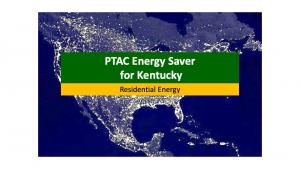- 1 read

Our GREENandSAVE Team is pleased to share information like this about sustainability solution providers. If you would like to submit information on your company, please contact us.
TIME TO ACT: Save 20% or more on HVAC. It’s important now more than ever for a sustainable future!
Optimizing PTAC units with a “smart” device is a fast, easy, and cost-effective way to achieve Residential HVAC Energy Savings. A Packaged Terminal Air Conditioner is a type of self-contained heating and air conditioning system commonly found in: Hotels, Motels, Senior Housing Facilities, Hospitals, Condominiums, Apartment Buildings, and Add-on Rooms & Sunrooms.
Business owners and homeowners face increasing challenges with energy costs to save energy and money in Kentucky. PTAC Energy Saver offers an Adaptive Climate Controller (ACC). It is a proven HVAC energy saving device that quickly installs on PTAC units. There are many companies that claim to produce energy savings, but the ACC device is multi-panted and proven over many years. Plus, it has extensive validation tests by organizations such as:
- ConEdison, Manhattan Plaza New York City
- Environmental Test Laboratory, Ohio
- EME Consulting Engineers (Third Party), Sponsored by NYSERDA, New York
- State University of New York, Oneonta, NY
- Tim Garrison (Third Party Testing)
- McQuay Cooling Tests
- Purdue University Tests (Phoenix)
- ConEdison Tests by ERS
Typically, when an HVAC system turns off, shortly after, the blower fan motor turns off. The ACC reprograms the blower fan not to shut off but to throttle back the rpm airflow to an exceptionally low speed, quiescent level airflow or “idle speed”. This allows for a gentle but continuous air movement into the building that helps keep equilibrium of climate conditions in the occupied space and saved energy.
PTAC Energy Saver can help you navigate the complexity of HVAC energy saving choices: CONTACT PTAC Energy Saver
Here is an example of some Residential HVAC Energy Saving info for Kentucky:
How to keep your home cool, cut costs as heat wave settles across central Kentucky
Summer is here, and Lexington residents can expect a heat index Tuesday and Wednesday reaching 109 degrees, according to a heat advisory issued Monday by the National Weather Service Louisville. The advisory, which remains in effect until 9 p.m. Wednesday, was issued for a swath of central counties across Kentucky, including Fayette, as well as parts of south central Indiana. Forecasters are urging residents to be mindful of the heat and remain on alert for signs of heat-related illnesses. Lexington also opened two public cooling stations Tuesday, and is offering free transportation to the sites via Lextran.
For those who can stay home, or simply want to keep things comfortable without running up a high bill, here’s some suggestions from the U.S. Department of Energy to combat the high temperatures.
Turn the fan on in the bathroom while you bathe to reduce heat and humidity. You might also use a fan in your kitchen and laundry room if available, and make sure your kitchen and bathroom fans vent to the outside. Leaving the ceiling fan on when you’re not in the room won’t help cool it down, because fans cool people with a wind-chill effect. They don’t actually reduce the temperature of a room. MAKE THE MOST OUT OF YOUR AIR CONDITIONER Vacuum your air vents regularly to remove dust. Make sure you don’t have furniture or other items blocking vents. It’s important to schedule regular maintenance on your air conditioner to try to avoid large, surprise issues. Don’t place lamps or electronics near your thermostat. The device may sense the heat from your TV set and run the air conditioner longer than is actually needed.
COVER YOUR WINDOWS Window coverings can help keep heat outside. You can use blinds, curtains, plastic films, exterior shades or storm windows as insulation. According to the Department of Energy, about 30% of your home’s energy is lost through windows. Utilizing a form of window shade can significantly reduce the amount of heat let into your home and subsequently lower your energy bill. Another window treatment option is an exterior solar screen. These can reduce heat gain, UV damage and glare while still typically allowing outside views and light transmission.
THINK TWICE ABOUT YOUR THERMOSTAT SETTING Keep your thermostat at a higher temperature than normal when you are away from the home while keeping in mind any pets you may be leaving behind.
When you get home, avoid setting a temperature that’s lower than your typical temperature. It doesn’t cool your home any faster, but it can add to your energy bill. If you’re trying to cool down quickly as you wait for your thermostat to adjust, you can focus on hydration or wash your face with cold water. OTHER WAYS TO CUT COSTS AND FIGHT HEAT You can lower your water heating costs while protecting against scalding by setting your water heater temperature to 120 degrees or lower. Another precaution you can take is to air-seal cracks and openings to prevent heat from seeping into your home. Caulking is generally used to seal openings around door and window frames, while weatherstripping seals moving components like doors and windows. If you can hold off on dishes and laundry, washing a full load is more efficient than using multiple smaller cycles.

